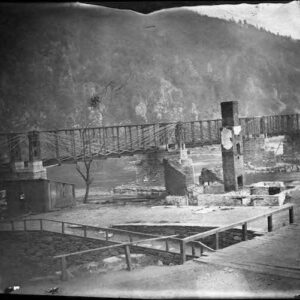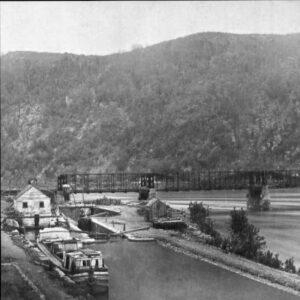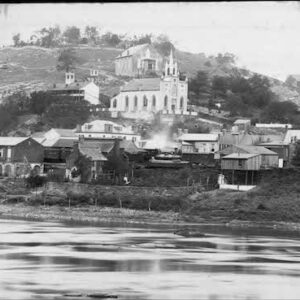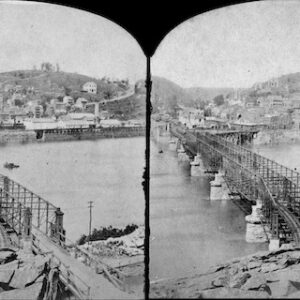Tag: Baltimore & Ohio Railroad (B&O)
Wikipedia says: The Baltimore and Ohio Railroad (reporting marks B&O, BO) was the first common carrier railroad and the oldest railroad in the United States, with its first section opening in 1830. Merchants from the city of Baltimore, which had benefited to some extent from the construction of the National Road early in the century, wanted to continue to compete for trade with trans-Appalachian settlers with the newly constructed Erie Canal (which served New York City), another canal being proposed by Pennsylvania (which would have connected Philadelphia and Pittsburgh), the Chesapeake and Ohio Canal (which connected to the nation’s capital, Washington, D.C., although it never reached Ohio), and the James River Canal, which directed traffic toward Richmond and Norfolk, Virginia. At first, the B&O was located entirely in the state of Maryland, its original line extending from the port of Baltimore west to Sandy Hook (opened in 1834). There it connected with Harper’s Ferry (by boat, then by the Wager Bridge) across the Potomac into Virginia, and also with the navigable Shenandoah River.
Because of competition with the C&O canal for trade with coal fields in western Maryland, the railroad could not use the C&O right-of-way west of Harpers Ferry. Thus, to continue westward through the Appalachian Mountains, the B&O chose to build the B & O Railroad Potomac River Crossing (1837) at Harpers Ferry, Virginia (since 1863, West Virginia). The line continued through Virginia to a point just west of the junction of Patterson Creek and the North Branch Potomac River, where it crossed back into Maryland to reach Cumberland (1842), connecting with the National Road, the main route westward. It reached the Ohio River at Moundsville, Virginia (1852), Wheeling (1853), where it built a terminus, and a few years later (1857) also to Parkersburg, Virginia, below rapids which made navigation difficult during parts of the year. It proved crucial to Union success during the American Civil War, although the conflict also caused considerable damage and repair costs. After the war’s end, the B&O consolidated several feeder lines in Virginia and West Virginia, as well as expanded westward into Ohio (including a junction at Portsmouth), Indiana, and Illinois. B&O advertising later carried the motto: “Linking 13 Great States with the Nation.”
American Civil War
At the outset of the Civil War, the B&O possessed 236 locomotives, 128 passenger coaches, 3,451 rail cars and 513 miles (826 km) of rail road, all in states south of the Mason–Dixon line, as Garrett had noted before the war began. Although many Marylanders had Southern sympathies, Garrett and Hopkins supported the Union. The B&O became crucial to the Federal government during the Civil War, being the main rail connection between Washington, D.C., and the northern states, especially west of the Appalachian mountains.
However, its initial problem became Lincoln’s first Secretary of War, Simon Cameron, a major stockholder in the rival North Central Railroad, which received long haul freight destined for Baltimore from the rival Pennsylvania Railroad. Furthermore, the Pennsylvania Railroad and other investors sought permission to construct rail lines which threatened the B&O’s monopolies on the Washington Branch (between Relay and Washington DC) and westward through Cumberland, Maryland. Raids and battles during the war also cost the B&O substantial losses, many never indemnified. Master of Transportation Prescott Smith kept a diary during the war years, describing incidents such as the June 1861 derailment of a 50 car coal train, which plunged into a ravine after a bridge was destroyed (the wreckage burned for months and melted the metal coal hoppers), as well as later ironclad trains (one only disabled by an artillery shell piercing the boiler).
1861–1862
On April 18, 1861, the day after Virginia seceded from the Union, Virginia militia seized the federal arsenal at Harpers Ferry, which was also an important work station on the B&O’s main westward line. The following day, Confederate rioters in Baltimore attempted to prevent Pennsylvania volunteers from proceeding from the North Central Railway’s Bolton station to the B&O’s Mount Clare station, and Maryland’s governor Hicks and Baltimore Mayor George W. Brown ordered 3 North Central and 2 Philadelphia, Wilmington and Baltimore Railroad (PW&B) bridges destroyed to prevent further federal troop movements through (and riots in) the city. Soon B&O president John Work Garrett received letters from Virginia’s Governor John Letcher telling the B&O to pass no federal troops destined for any place in Virginia over the railroad, and threatening to confiscate the lines. Charles Town’s mayor also wrote, threatening to cut the B&O’s main line by destroying the long bridge over the Potomac River at Harpers Ferry, and Garrett also received anonymous threats. Thus he and others asked Secretary of War Cameron to protect the B&O as the national capitol’s main westward link. Cameron instead warned Garrett that passage of any rebel troops over his line would be treason. The Secretary of War agreed to station troops to protect the North Central, the Pennsylvania Railroad, and even the PW&B, but flatly refused to help the B&O.
The B&O had to repair damaged line at its own expense, and often received late or no payment for services rendered to the federal government. In May, CSA Colonel Jackson’s operations against the B&O Railroad (1861) began. Stonewall Jackson initially permitted B&O trains to operate during limited hours over the approximately 100 miles from Point of Rocks to Cumberland. On June 20, 1861, Jackson’s Confederates seized Martinsburg, a major B&O work center, having had blown up the Harpers Ferry railroad bridge on June 14. Confederates confiscated dozens of locomotives and train cars and ripped up double track in order to ship rails for Confederate use in Virginia (14 locomotives and 83 rail cars were dismantled and sent south, and another 42 locomotives and 386 rail cars damaged or destroyed at Martinsburg, with the B&O water station and machine shops also destroyed and 102 miles (164 km) miles of telegraph wire removed by the time federal control was restored in March 1862). By the end of 1861, 23 B&O railroad bridges had been burned and 36.5 miles (58.7 km) of track were torn up or destroyed.
Since Jackson cut the B&O main line into Washington for more than six months, the North Central and Pennsylvania Railroads profited from overflow traffic, even as many B&O trains stood idle in Baltimore. Garret tried to use his government contacts to secure the needed protection, from Maryland Delegate Reverdy Johnson to General George McClellan and Treasury Secretary Salmon P. Chase. As winter began, coal prices soared in Washington, even though the B&O in September arranged for free coal transport from its Cumberland, Maryland, terminal down the C&O Canal (which reduced prices somewhat, although Confederates also damaged the C&O canal that winter). Furthermore, western farmers could not get their produce to markets because of the B&O shutdown, only partially alleviated by the summer 1861 Union army victories at the Battle of Philippi (West Virginia) and Rich Mountain, and vigorous army and company work crews which reduced the main-line gap to 25 miles between Harpers Ferry and Back Creek.
Finally at year end, Samuel M. Felton, the PW&B President, wrote newspapers about the War Department’s discrimination against his cooperating railroad line, which competed with Cameron’s favored North Central and Pennsylvania Railroads. President Lincoln (familiar with railroad law since his days as an Illinois lawyer) in January 1862 replaced Cameron with Pennsylvania lawyer Edwin M. Stanton, who had been serving as Cameron’s legal advisor. Furthermore, on January 31, 1862, Congress passed the Railways and Telegraph Act of January 31, 1862, creating the United States Military Railroad and allowing it to seize and operate any railroad or telegraph company’s equipment, although Stanton and USMRR Superintendent Daniel McCallum would take a “team of rivals” approach to railroad management and allow civilian operations to continue. In February 1862, Union forces recaptured Martinsburg and Harpers Ferry, and work crews continued replacing wrecked bridges and equipment, although bushwhacker raids continued. Even then train movements were sporadic and subject to frequent stoppages, derailments, capture and attack. Prominent raids on the B&O railroad during this period were:
The Great Train Raid of 1861, May 22 – June 23, 1861
The Romney Expedition, January 1 through January 24, 1862
Operations during the Maryland Campaign, September 8, 1862
Various raids of Brigadier General A. G. Jenkins, Fall, 1862
1863–1865
The second half of the Civil War was characterized by near-continuous raiding, which severely hampered the Union defense of Washington, D.C. Union forces and leaders often failed to properly secure the region, despite the B&O’s vital importance to the Union cause.
“There is no interest suffering here except the Baltimore and Ohio Railroad and I will not divide my forces to protect it.”
— General Philip Sheridan
This military strategy, or lack thereof, allowed Confederate commanders to contribute significantly to the length of the war, by conducting free-ranging military operations against the region and railroad.
Before the Battle of Monocacy, B&O agents began reporting Confederate troop movements eleven days prior to the battle, and Garrett had their intelligence passed to authorities in the War Department and to Major General Lew Wallace, who commanded the department responsible for defense of the area. As preparations for the battle progressed, the B&O provided transport for federal troops and munitions, and on two occasions Garrett was contacted directly by President Abraham Lincoln for further information. Though Union forces lost this battle, the delay allowed Ulysses S. Grant to successfully repel the Confederate attack on Washington at the Battle of Fort Stevens two days later. After the battle, Lincoln paid tribute to Garrett as:
“The right arm of the Federal Government in the aid he rendered the authorities in preventing the Confederates from seizing Washington and securing its retention as the Capital of the Loyal States.”
— Abraham Lincoln
The Jones-Imboden Raid, April 24 through May 22, 1863
The Catoctin Station Raid, June 17, 1863
The First Calico Raid, June 19, 1863
The B&O Raid on Duffield Station, January 1864
The McNeill Raid, May 5, 1864
The Second Calico Raid, July 3, 1864
The Battle of Monocacy, July 9, 1864
Gilmor’s Raid, July 11, 1864
The Greenback Raid, by Mosby’s Rangers on October 14, 1864
The B&O Raid on Duffield Station II, January 1865
Gilmor’s B&O Raid, February 1865
The B&O Derailment Raid, March 1865
The Confederate leaders who led these operations and specifically targeted the railroad included:
Lieutenant General Thomas J. “Stonewall” Jackson and many units under his command
Lieutenant General Jubal Anderson Early and many units under his command
Brigadier General Turner Ashby and his “Black Horse” cavalry
Brigadier General John D. Imboden and the 62nd Virginia Mounted Infantry (1st Partisan Rangers)
Brigadier General Albert G. Jenkins and the 8th Virginia Cavalry
Brigadier General William E. “Grumble” Jones and the “Laurel Brigade”
Colonel John S. Mosby’s “Mosby’s Rangers”
Major Harry Gilmor’s “Gilmor’s Raiders”
Captain John H. McNeill’s “McNeill’s Rangers”
Bases of operation involved in raiding the B&O Railroad:
Winchester, Virginia
Harpers Ferry, West Virginia
Showing 1–16 of 33 resultsSorted by latest
-

Image ID: AZOC
$3.99 -

Image ID: AYLP
$0.99 -

Image ID: AYPI
$0.99 -

Image ID: AXXZ
$0.99 -

Image ID: AYFR
$0.99 -

Image ID: AYFS
$0.99 -

Image ID: AYLO
$0.99 -

Image ID: ASMX
$1.99 -

Image ID: AXXR
$0.99 -

Image ID: AUDI
$0.99 -

Image ID: AXBV
$4.99 -

Image ID: AJLA
$6.99 -

Image ID: AQII
$3.99 -

Image ID: AYMQ
$0.99 -

Image ID: AJGT
$5.99 -

Image ID: AJHN
$6.99 This product has multiple variants. The options may be chosen on the product page